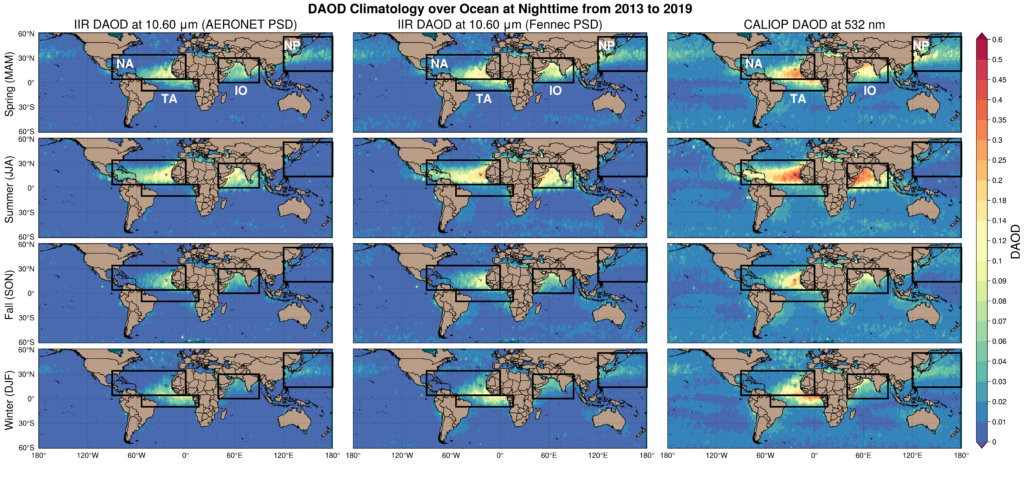Infrared (10 µm) dust aerosol optical depth retrieved over global ocean based on the combination of CALIOP and IIR [Zheng et al. 2021 Remote Sensing of Environments]
Link to the data: https://data.mendeley.com/datasets/bd85vzyf96/3

Background
Recent studies have suggested that global climate models tend to underestimate dust particle size in particular, the very coarse mode, leading to an underestimated direct radiative effect (DRE) of dust in the longwave (LW) thermal infrared (TIR) region. However, the magnitude of LW DRE remains highly uncertain, because of limited observations of dust optical depth at the TIR (DAODTIR). This study presents a simple approach to retrieve the DAODTIR over the oceans during nighttime through synergistic use of observations from the Infrared Imaging Radiometer (IIR) and the Cloud-Aerosol Lidar with Orthogonal Polarization (CALIOP), both onboard of the Cloud-Aerosol Lidar and Infrared Pathfinder Satellite Observations (CALIPSO) mission. For each cloud-free dust-laden profile identified by the IIR-CALIOP observation, a Lookup-Table (LUT) of the 10.6 μm IIR band brightness temperatures (BT) difference (dBT) under different DAODTIR with respect to their dust-free BTs is constructed based on the CALIOP retrieved dust vertical profile and a priori dust scattering properties using a fast radiative transfer model. Then the DAODTIR is retrieved by projecting the IIR-observed dBT on the LUT. Sensitivity studies show that the DAODTIR retrieval at 10.6 μm is more susceptible to the dust particle size distribution (PSD) assumption than dust refractive indices. To estimate the uncertainty caused by PSD assumption, two DAODTIR retrieval products, one based on the dust PSD from the AERONET at Cape Verde and the other on an in situ measured PSD from the recent Fennec campaign, are provided. The retrieval uncertainty is mainly contributed by the BT difference between the observation and simulation using auxiliary atmospheric data. The climatology of the retrieval from 2013 to 2019 shows reasonable spatiotemporal variations of DAODTIR with the global-averaged value of 0.008 and 0.013 based on different pre-assumed dust PSDs. Climatological results agree reasonably well with two independent DAODTIR retrieval products based on the Infrared Atmospheric Sounding Interferometer (IASI) over the active dust transport regions, such as North and Tropical Atlantic (r = 0.9 and r = 0.8) and Indian Ocean (r = 0.8). The seasonal and interannual variation is also well-compared (r = 0.76) with AERONET coarse-mode AOD at 97 selected sites. The synergic CALIOP observation allows the retrieved DAODTIR to directly compare with the extrapolated DAODTIR from DAOD in the visible (i.e., 532 nm), which helps evaluate the observational constraints on DAODTIR. Our study clearly reveals that the retrieved DAODTIR from IIR is much less susceptible to various uncertainties than converted results from CALIOP. It also offers a unique prospect of collocated active lidar and passive IR observations for retrieving dust DAODTIR.
Data Description
————-
– The dust aerosol optical depth (DAOD) at 10.6 microns was retrieved from the integrated IIR and CALIOP onboard CALIPSO, developed by ACROS Group at University of Maryland Baltimore County (UMBC).
– There are two retrieval products based on two dust particle size distribution (PSD) assumptions.
One is the AERONET Cape Verde climatological PSD averaged from 1993 to 2000 (Dubovik et al. 2002).
The other is the Fennec-SAL PSD measured from the Fennec Campaign in June 2011 over the eastern Atlantic Ocean (Ryder et al. 2013).
– The mean dust layer height represents where the extinction column is half of the total extinction column from CALIOP.
– The Brightness Temperature (BT) simulated by FASDOM is valid only when the retrieval is implemented.
– The pre_quality (pre_QA) flag is set depending on cloud coverage (both cloud-free and partial cloud-free 5-km pixels are processed) and should be used at all times (pre_QA <= 1).
– The post_quality (post_QA) flag should be used at all times, as it removes unreliable retrievals (post_QA == 0).
– The dust flag is set to identify cloud-free dust pixel and should be used at all times (Dust_Flag == 1).
– The data only covers oceans at nighttime. The future version will include daytime and possibly covers lands.
– The Level-2 (L2) data is processed and stored with temporal resolution as Daily.
– Latitude and longitude in the L2 data are corresponding to the along-track footprint of CALIOP in 5-km resolution.
– The Level-3 (L3) data is processed and stored as 1 degree latitude by 1 degree longitude with temporal resolution as Monthly.
– Both the pre_QA (pre_QA <= 1) and post_QA (post_QA == 0) flags are applied in L3 data.
Version history
—————
V3. First version corresponding to the preprint version.
V4. Added vertical distribution of both DAOD at 10.6 μm and at 532nm up to the altitude of 12km. Changed all file to netCDF format.
Publications
—————
1. Zheng, J., Zhang, Z., Garnier, A., Yu, H., Song, Q., Wang, C., Dubuisson, P., Biagio, C.D., n.d. The thermal infrared optical depth of mineral dust retrieved from integrated CALIOP and IIR observations. https://doi.org/10.1002/essoar.10507408.1
References:
Zheng, J., Zhang, Z., Garnier, A., Yu, H., Song, Q., Wang, C., et al. (2022). The thermal infrared optical depth of mineral dust retrieved from integrated CALIOP and IIR observations. Remote Sensing of Environment, 270, 112841. https://doi.org/10.1016/j.rse.2021.112841
Dubovik, O., Holben, B., Eck, T.F., Smirnov, A., Kaufman, Y.J., King, M.D., Tanré, D., & Slutsker, I. (2002). Variability of Absorption and Optical Properties of Key Aerosol Types Observed in Worldwide Locations. Journal of the Atmospheric Sciences, 59, 590-608
Ryder, C.L., Highwood, E.J., Lai, T.M., Sodemann, H., & Marsham, J.H. (2013a). Impact of atmospheric transport on the evolution of microphysical and optical properties of Saharan dust. Geophysical Research Letters, 40, 2433-2438